You have always wanted to try infrared photography, but you’ve been lead to believe that this can only be done using expensive IR cameras? This article is for you! Read about how you can build yourself a digital IR camera for just a few dollars.
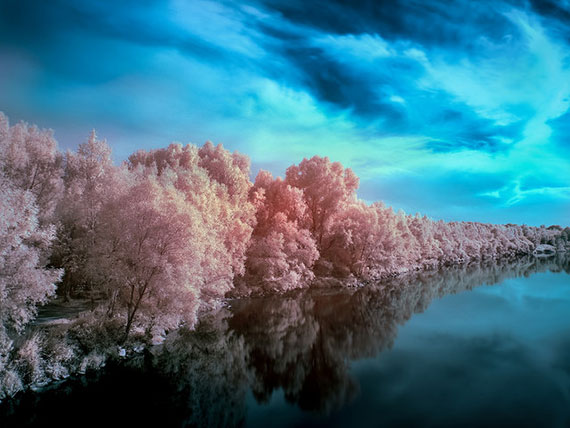
Photo by zeitfaenger.at
Notes to the Reader
This article covers some of the basic principles of IR photography. It also tells the story of a project involving the modification of a number of digital cameras. The cameras were converted to be used as IR cameras. The aim of the project was to do the IR conversion as cheaply as possible.
Important disclaimer: Taking apart a perfectly good, fully functional, digital camera, is risky in more ways than one. There is the possibility of electrocution (through highly charged capacitors within the camera) and there is a real chance that the camera may never work again. I take no responsibility for any such mishap. The risk is yours completely; so are the rewards afterward if you get it right!
At the time of writing this, the NZ$ is worth about 70 cents American.
The Trigger and the Motivation
I am a simple man. I sometimes get involved in projects of a complex nature and may on the odd occasion fiddle with technologies which may be classed as “modern” or “advanced.” By nature, though, I like to simplify things if at all possible. I also believe that many times we are precluded from doing worthwhile things by society telling us, “It’s difficult,” “It’s too expensive,” or “You’ll never be able to do that. Only certain people can do that, and you are not one of them.”
In this article I aim to prove to you that you too can do IR photography. In fact, you can produce stunning IR photos using a home-built camera on a very tight budget if:
- You are prepared to invest a very modest sum of money in getting together the parts needed.
- You have the practical skills needed to take something apart and put it back together again (or know someone who can help you with that).
- You can cut and shape a small piece of glass (or get someone to do it for you).
- You have any knack at all for taking decent photographs.
- You are prepared to risk “getting it wrong” or “screwing it up.”
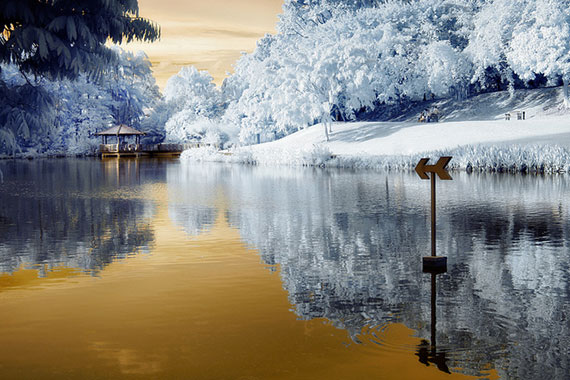
Photo by digitalpimp.; f/9.0, 1/80-second
Resources
Before you set off on this journey, you may want to get some more information on the subject. Fortunately there is a lot of information accessible on the Internet.
For information on camera conversions:
- Infrared Photography with a Digital Camera (This article serves as a very good starting point for information on digital IR photography.)
- Infrared Sensitivity Comparisons (Different cameras are compared here. You can also go to the page on digicam modification for detailed instructions on how to modify an Olympus 2040.)
- DPanswers: IR Photography (This article covers a whole raft is issues and contains links to many more resources.)
- Canon G-Series Infrared Conversion (This article contains instructions on modifications on a Canon G1. It has very well documented steps and photos.)
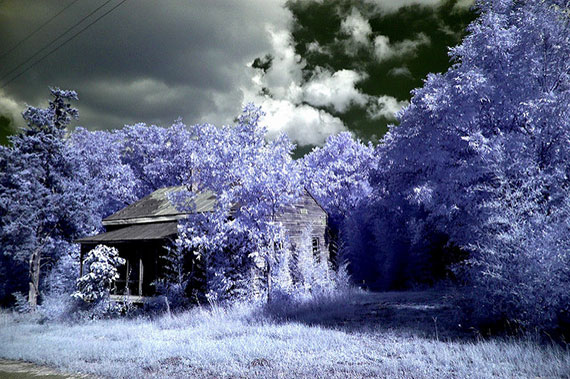
Photo by Neal Wellons; ISO 100, f/3.3, 1/640-second exposure.
In some instances, the articles mentioned above will give you all the details needed to convert a specific camera. Some of them refer you on to other sites where once again modifications to cameras are described and detailed. Even if you do not intend to convert one of the cameras covered in these articles, it is worth the while to scan through them. You then get an idea of what a digital camera looks like on the inside and how they are constructed. You will learn a lot by just scanning through the articles contained in this list!
Some more information on IR photography (using digital cameras) can be found at LifePixel and other similar sites.
You can also search the Internet for sources of your own using phrases such as:
- “infrared camera conversion”
- “infrared photography”
- “IR photography”
You may also go to a local library and ask about IR photography. Many libraries will only have books and references on IR film photography but you may be lucky and get info on digital photography from yours. It all depends on how modern and up-to-date your library services are.
IR Photography Concepts
I am going to assume that you have a basic grasp of the principles of IR photography. Even though you need not be an expert on these, I suggest you familiarize yourself with the following before you proceed with this article:
- What is infrared light?
- How does it differ from light in the visible spectrum?
- Why is it we can not see it but digital cameras can ?
- How does a digital camera capture a picture?
- What is a CCD?
- What does a camera’s mega pixels(MP) value indicate?
- What does a “hot filter” do, and why is it found inside most digital cameras?
- Manipulating JPEG files on a personal computer
- Utilizing graphics software
The mere fact that you are reading this article tells me that you have an interest in IR photography. You may also be keen on taking your own IR photos and manipulating them. I take that to be a good sign and trust that you will “fill in the gaps” around missing information where and when needed.
From experience I can tell you that:
- You do not need a specialized IR camera costing hundreds (or thousands) of dollars to do IR photography.
- You do not need to use a DSLR for infrared photography. A cheap digital camera that has been converted for IR photography can take stunning IR photos. It will most likely not suffer from long exposure times and can be utilized as easily as any other digital camera.
- It is not that difficult to convert a suitable point-and-shoot digital camera for IR photography.
- Suitable cameras and the materials needed to build your own dedicated IR camera can be sourced cheaply if you have access to the Internet and a reliable postal service. You may already posses some of the tools and/or may be able to get the components and tools in stores close to home.
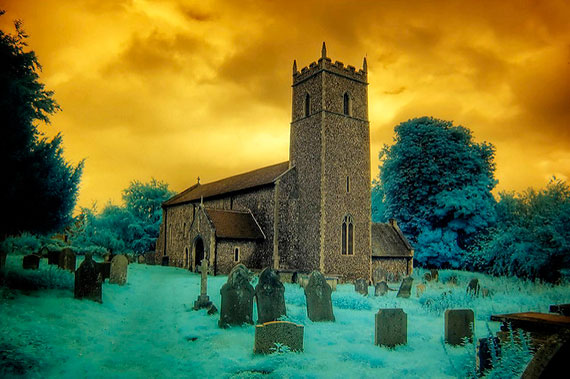
Photo by David; ISO 100, f/8.0, 1/49-second exposure.
What You Need
You will need the following during the construction phase of your IR photography project:
- A suitable camera. There are numerous references to suitable cameras on the internet. You may want to read my comments on what I considered suitable cameras below. This will give you an indication of how I went about it. As you will most likely be buying second hand goods, ensure that the deal includes a memory card, charger for the battery (if applicable) and some software (good to have) for downloading the photo files. A carry case is good to have but not essential.
- A suitable IR filter. You will most likely be able to get this from a photography shop, photographic retailer or the like. If you are able to source goods over the Internet and can have it delivered to your home, you will not find it difficult to get a suitable filter. Consider buying at least two or three different filters. If you do, the filters should be spaced far enough apart (in terms of their respective cut-off points) to allow you to experiment with different lighting conditions, more or less Woods effect etc. Note that you may not only have to buy filters for use as filter elements, but you may have to buy some filters to cannibalize for their parts.
- Some basic tools. These include one or two jeweler’s screwdrivers, a glass cutter, a diamond-impregnated file, masking tape, a fine-pointed semi-permanent pen, tweezers and blu tack. You may or may not want to use vernier calipers to measure the glass element that needs replacing inside the camera. More about that later.
- A suitable workplace. The workplace should be clean, uncluttered and well-lit. It should preferably be set up such that you can leave the project there indefinitely while searching for, constructing or waiting for parts.
- A few consumables like paper cloths, cleaning liquid, epoxy glue, earbuds and a clean handkerchief or two.
- Enough time to complete the project. A typical build can take an evening or two of full-on work but may extend out to a week or two if you have to wait for delivery on goods which had been ordered
Basic Tools
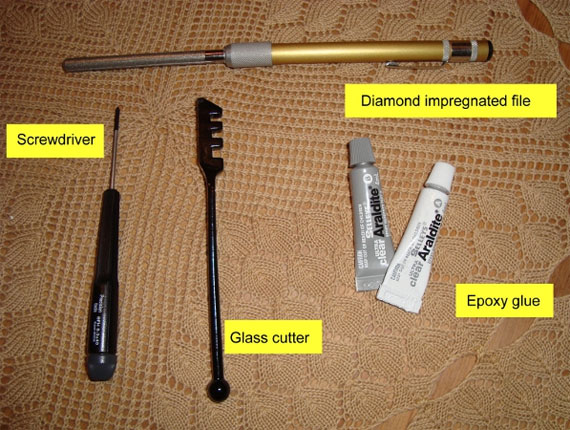
Infrared Photography Tools
You may not need all of the tools shown in the two photos. Most are cheap and easy to find.
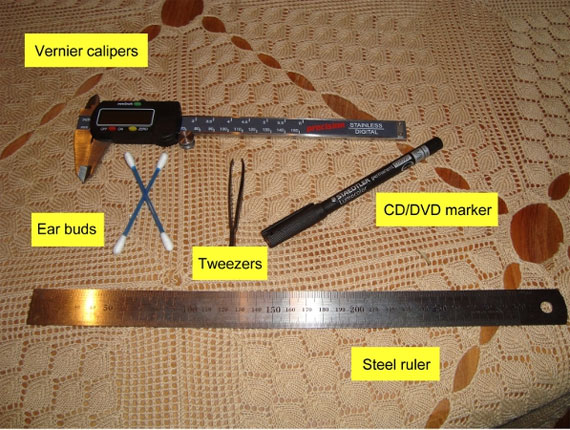
Additional Infrared Photography Tools Needed
Once you have completed your camera you will need:
- A memory card suited to your camera. Some cameras have internal memory allowing you to store photo files on the camera itself. It is however always worth the while to get a memory card. The files are downloaded so much easier and the storage capacity is increased many times over.
- Batteries, a battery pack, or power source for your camera.
- If your camera allows for manual white balancing, you will need a gray card to allow for this action. You need not spent lots of money on this; see notes later in this article.
- Suitable subject material for your photo shoot.
- Sufficient light and suitable weather conditions for the shoot.
- Means of getting the files from the camera on to the computer. You may transfer the information by means of a cable connection or by taking the memory card from the camera and slotting it into a suitable card reader. Consult the instruction manual for your camera for more information on how to do this.
- Access to a personal computer and suitable software for image manipulation. Once again this need not cost you a cent. You can download GIMP from the Internet and use it to process our photos. There are Gimpuser tutorials which teach you how to take a color photo and convert it to grayscale or how to change around the colors for false-color photography. You will basically be doing one of these two actions to convert your IR photo into a stunning work of art. See http://www.gimpusers.com/tutorials/infrared-monochrome.html
- A tripod is handy in that it allows you to take photos in poor lighting conditions.
Things to Keep in Mind About IR Photography
- IR photography is as much an experimental process as it is an art form. You never quite know what you are going to get when you press the shutter release. You are for ever experimenting, always trying different things and you need to take lots of photos to maybe get the outcome you hoped for.
- IR photo’s need not be sharply focused, crisp and clear. In fact much of the allure of this art form is contained in its ghostly appearance, its dreamy atmosphere and sometimes surrealistic appearance. I will be referring to this later on within the article.
- Digital IR photography has very real advantages over IR film photography. The old IR films had to be treated with great care to prevent fogging and had to be developed by experienced photo laboratory staff or dedicated amateurs. It was not easy and it was not cheap. Digital photography and the process of producing an IR image of your own does not cost a cent. That’s right! Once you have modified your camera and added the bits needed to get it to do IR photography, the only real expenditure will be toward batteries for the shoot. You can upload your own photos, “process” them, and produce results without any real cost. This is especially important when you consider that you will be taking lots of photos to see which ones are useful and which ones are not.
Proceed to Part 2: My Own Infrared Camera Project
About the Author:
Pieter Albertyn is a self-confessed “tinkerer” and amateur photographer. He lives in Napier, New Zealand. Pieter has previously been involved in product development and systems engineering. He loves to modify utility products, enhance their features and develop basic logistical support systems for them. Though he works in an English dominated workplace, English is his second language.
Like This Article?
Don't Miss The Next One!
Join over 100,000 photographers of all experience levels who receive our free photography tips and articles to stay current:






Very interesting article! I need to get out with my converted Sony Alpha 100 and start shooting. Had it switched to b&w IR some years ago and have had fun with it. What I really miss, however, is the old Kodak HIE IR film. Learned how to use it in a college summer class and just love what that film could do. Picky to use and pickier to develop but the wow factor! Great film. And then Kodak discontinued it. What a sad day when that was announced. Anyway, seeing this article is nudging me so thank you for it!
I use Nikon D70S and D700 cameras. Is IR conversion costly? Is it permanent? Where can I have it done in Canada?
Hi,
Thanks for these information.
I want to know if you have some tips to do a good focus setting. I use IR filter,
Thanks!
A lot of great info in this article! Here are some IR time lapses I shot on a converted 5Dmkiii. Much better than going with a filter as I had more control over the exposure, very pleased with the result!
https://vimeo.com/168578611
Nikon D40x with infra red filter. No disassembling required!! ; ))
Very well written!
There is a very nice IR Photography thread here: http://www.uglyhedgehog.com/t-3448-1.html It has tips, tricks, and a lot of images, links and advice. Good place to view what others are shooting in IR and their equipment and techniques.
Great place for a newbie interested in IR and wondering how to get started.
Eric L
You don’t have to do any “conversion”, just buy an infrared filter and TAPE it to front of your lens (or hold it by your hand).
I have been testing infrared films and ordinary colour films with infrared filters and the results are – about the same, in case you know how to calculate the exposure. With digital cmos the result would be exactly same (switch off auto white balance before shooting).
It’s just matter of FILTERING OUT other wavelenghts than mostly unvisible infrareds (actually the range is quite narrow band, just at the edge of visible light, what films/cmos can catch; the True Infrared cameras has cmos/ccd that has calibrated to way lower wavelenghts).
Generally “IR-photography” in consumer markets is called “false IR photography”; and frankly, it is actually that, as most of the information is from visible light.
The “IR” effect amount is about the same than UV-lights in discos to make glow some materials/paints.
But be creative with interesting, unpredictable results ;)
Hi Pieter, I would like to contact you, so can you email me your phone number. Thanks
Great tutorial on infrared photography. It’s amazing how this imaging technique produces as stunning images today as it did 100 years ago. Fascinating. Check out these IR pictures taken by the legendary Weegee in the 1940s! http://forwardthinkingmuseum.com/exh_grp_IR_art_weegee1.php